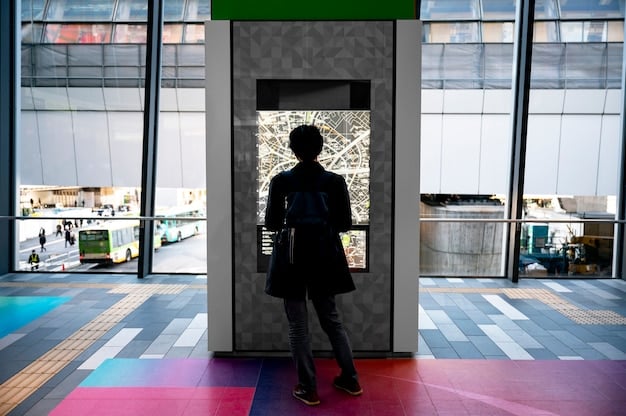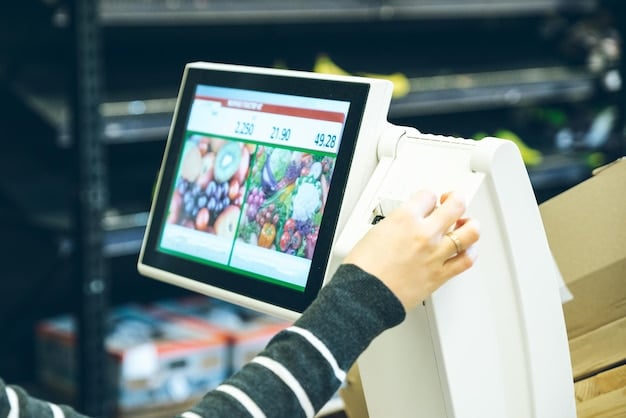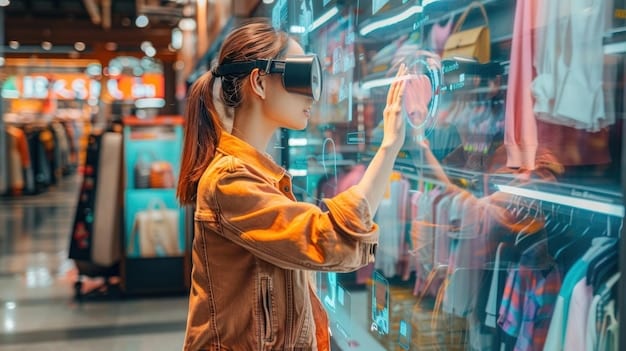AI in Retail: Revolutionizing US Stores with Inventory & Customer Engagement

AI in Retail is transforming inventory management and customer engagement in US stores by offering real-time data analysis, personalized shopping experiences, and optimized operational efficiency.
The retail landscape in the United States is undergoing a significant transformation, driven by advancements in artificial intelligence. **AI in Retail: Improving Inventory Management and Customer Engagement in US Stores** is no longer a futuristic concept but a present-day reality, reshaping how retailers operate and interact with their customers.
Understanding the Role of AI in Modern Retail
Artificial intelligence is rapidly changing the retail industry, especially in the United States. From enhancing inventory accuracy to personalizing customer interactions, AI offers a broad spectrum of solutions that can optimize retail operations and improve the overall shopping experience.
Enhancing Operational Efficiency
AI algorithms can analyze vast amounts of data to predict demand, optimize staffing, and streamline supply chain logistics, leading to more efficient and cost-effective retail operations.
Improving Customer Experience
AI enables personalized recommendations, targeted marketing, and seamless omnichannel experiences, ultimately enhancing customer satisfaction and loyalty.
- Predictive Analytics: AI’s ability to forecast trends and manage inventory proactively.
- Personalized Recommendations: How AI algorithms provide tailored product suggestions.
- Chatbots and Virtual Assistants: The role of AI in delivering immediate customer support.
AI’s capability transcends mere data processing; it revolutionizes retail by enabling informed decision-making and fostering customer loyalty through personalized experiences.

Optimizing Inventory Management with AI
Effective inventory management is crucial for retail success. AI provides tools that can significantly improve inventory accuracy, reduce stockouts, and minimize waste, leading to substantial cost savings and increased profitability for retailers.
Real-time Inventory Tracking
AI-powered systems can track inventory levels in real-time, providing visibility into stock levels across all locations and channels.
Demand Forecasting
AI algorithms can analyze historical sales data, market trends, and external factors to predict future demand accurately, allowing retailers to optimize their inventory levels.
- Automated Replenishment: AI systems automatically trigger reorders when stock levels fall below predetermined thresholds.
- Waste Reduction: By optimizing inventory, AI minimizes waste and spoilage, particularly in industries like grocery and fashion.
- Reduced Stockouts: Accurate demand forecasting ensures that products are available when customers want them, reducing lost sales.
Investing in AI-driven inventory management solutions translates to tangible benefits, empowering retailers to meet customer demand proactively and efficiently.
Personalizing Customer Engagement Through AI
In today’s competitive retail environment, personalized customer engagement is essential for building loyalty and driving sales. AI empowers retailers to deliver tailored experiences that resonate with individual customers, creating lasting relationships.
Targeted Marketing Campaigns
AI can analyze customer data to identify segments with specific needs and preferences, allowing retailers to create targeted marketing campaigns that are more effective.
Personalized Recommendations
AI algorithms can provide personalized product recommendations based on a customer’s purchase history, browsing behavior, and demographic information.
- Chatbot Interactions: AI-powered chatbots provide instant customer support and personalized shopping assistance.
- Loyalty Programs: AI can track customer loyalty and rewards, enabling personalized offers and discounts.
- Predictive Customer Service: AI anticipates customer needs, offering proactive assistance and resolving issues before they escalate.
By harnessing the power of AI, retailers can transform customer interactions into personalized experiences that foster loyalty and drive business growth.
Implementing AI Solutions in US Retail Stores
Adopting AI solutions requires careful planning and execution. US retailers must consider various factors, including data privacy, employee training, and integration with existing systems to ensure successful implementation and maximize the benefits of AI.
Data Privacy Considerations
Retailers must comply with data privacy regulations and ensure that customer data is handled securely and ethically.
Employee Training and Development
Employees need to be trained on how to use and interact with AI-powered systems to ensure a smooth transition and effective implementation.
- Integration with Existing Systems: AI solutions should be seamlessly integrated with existing retail systems, such as point-of-sale (POS) and enterprise resource planning (ERP) systems.
- Pilot Programs: Starting with pilot programs can help retailers test and refine their AI strategies before scaling them across the entire organization.
- Phased Rollout: A phased rollout approach allows retailers to prioritize and implement AI solutions incrementally.
Strategic implementation of AI is essential for long-term success, guaranteeing retailers realize the full potential of these technologies while maintaining customer trust and operational coherence.

Overcoming Challenges in AI Adoption
While AI offers significant benefits, retailers may face challenges in adopting these technologies. Addressing these challenges proactively is essential for successful AI implementation and maximizing the return on investment.
Data Silos and Integration Issues
Breaking down data silos and integrating AI solutions with existing systems can be complex and require significant effort.
Lack of Technical Expertise
Retailers may lack the internal expertise needed to implement and manage AI solutions effectively, requiring them to partner with external consultants or hire skilled professionals.
- Cost Considerations: AI solutions can be expensive, and retailers need to carefully evaluate the costs and benefits before investing.
- Resistance to Change: Employees may resist the adoption of AI technologies, requiring change management strategies to address their concerns and ensure buy-in.
- Ensuring Data Quality: The accuracy and reliability of AI algorithms depend on the quality of the data they are trained on, requiring retailers to invest in data cleansing and validation processes.
Proactive management of these potential challenges equips retailers to navigate the complexities of AI adoption and fully capitalize on the transformative potential of these technologies.
Future Trends in AI and Retail
The field of AI is constantly evolving, and retailers must stay abreast of the latest trends to maintain a competitive edge. Emerging technologies like generative AI, computer vision, and edge computing hold the potential to further transform the retail industry.
Generative AI
Generative AI can create new content, such as personalized product descriptions, marketing copy, and even store layouts, enabling retailers to deliver even more engaging and tailored experiences.
Computer Vision
Computer vision enables AI systems to “see” and interpret images and videos, allowing for applications like automated checkout, loss prevention, and enhanced in-store analytics.
- Edge Computing: Processing data closer to the source, such as in-store cameras and sensors, reduces latency and enables real-time decision-making.
- Augmented Reality (AR): AI-powered AR applications can enhance the shopping experience by allowing customers to virtually try on clothes, visualize furniture in their homes, and access product information in a more immersive way.
- Robotics: Robots can automate tasks like shelf stocking, cleaning, and customer service, improving efficiency and freeing up employees to focus on more strategic activities.
As technology advances, the integration of these trends will redefine retail paradigms, offering enhanced efficiency, customer engagement, and unprecedented insights.
| Key Area | Brief Description |
|---|---|
| 📊 Inventory Optimization | AI enhances inventory accuracy, reducing stockouts and waste. |
| 🛍️ Personalized Experience | AI drives targeted marketing and personalized shopping journeys. |
| 🤖 Automation | AI automates tasks like stocking and customer service. |
| 🔒 Data Privacy | Ensuring secure and ethical handling of customer data. |
Frequently Asked Questions
AI enhances inventory management by predicting demand, tracking stock levels in real-time, and automating the replenishment process, thereby reducing waste and preventing stockouts.
Chatbots provide instant customer support, personalized shopping assistance, and handle routine inquiries, allowing human staff to focus on more complex customer needs, enhancing overall engagement.
AI personalizes the shopping experience through targeted marketing campaigns, personalized product recommendations based on purchase history, and tailored loyalty programs that cater to individual customer preferences.
Retailers might encounter challenges like data silos, integration issues with existing systems, a lack of technical expertise, high implementation costs, and employee resistance to change during AI adoption.
Future trends include generative AI for content creation, computer vision for automated checkout, edge computing for real-time decisions, AR for immersive experiences, and robotics for automating repetitive tasks.
Conclusion
In conclusion, **AI in Retail: Improving Inventory Management and Customer Engagement in US Stores** is revolutionizing the industry. By optimizing inventory, personalizing customer interactions, and automating key processes, AI is empowering US retailers to thrive in an increasingly competitive market, providing superior shopping experiences and achieving operational excellence.





